Chitra Banerjee Divakaruni's Blog, page 4
January 25, 2016
Chocolate Sandesh: A Dish from My Upcoming Novel, Before We Visit the Goddess
My new novel, Before We Visit the Goddess, will be out in April 2016.
The birth of each new book is a very exciting event for me. I think I'm looking forward to this one as much as I did to my first collection of stories, Arranged Marriage!
Here is a preview of the book jacket.

The book is about three generations of women–grandmother, mother and daughter–who must each examine for herself what it means to be a successful woman. Here's a link to a more detailed description: http://books.simonandschuster.com/Before-We-Visit-the-Goddess/Chitra-Banerjee-Divakaruni/9781476792002
To advance-celebrate the publication of the novel, I thought I would post a recipe that's important in the book. The grandmother, Sabitri, is a renowned sweet-maker in Kolkata and owns her own sweet shop, Durga Sweets. Her daughter's favorite sweet is chocolate sandesh. It's used to be one of my favorite desserts when I was growing up, too. I guess life finds its way into art!
I tried various recipes of chocolate sandesh, including one from my mother, but the best one came from this website, Manjula's kitchen. (Sorry, Mom!) I decided I would share it with all of you today. It's an excellent website – you'll find many good recipes there.
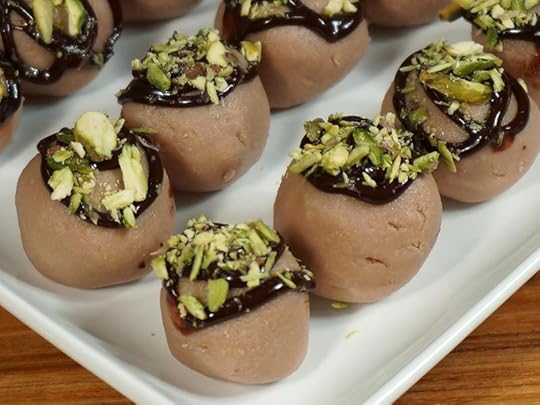
Chocolate sandesh, Manjula's recipe
http://www.manjulaskitchen.com/new-chocolate-sandesh-truffles/
I did not add pistachios to mine, as I like the flavor of chocolate by itself. I also cheated and used store-bought paneer, and mashed and warmed it in a heavy, nonstick pan on the stove until it became soft! It made the process very quick. The chocolate sauce drizzled on top is optional. The sandesh tastes delicious even without it.
Enjoy – and let me know what you think. As always, I'd love for you to share your recipes with me.

May 25, 2015
Yogurt Rice, an Easy, Healthy Indian Comfort Food
Although my husband Murthy and I are both Indian, I come from Bengal and he from the state of Andhra Pradesh, and our cuisines are different in many ways. Marriage to him, in fact, has made me realize how diverse the culture of India is, a fact that I’ve tried to explore in novels such as One Amazing Thing and Oleander Girl.
Over the years, I’ve learned to cook several of the comfort dishes that put a smile on Murthy’s face. Today I made yogurt (curd) rice, South Indian style.

Friends who saw the photo I posted on my Facebook page wanted the recipe, so here it is.
As with most of my cooking, it’s simple and quick. (Life is just too short--I'm prepared to spend only so much of it cooking!) I use leftover rice, but you can also make fresh rice and spread it out to cool. If you want to experiment, you can use brown rice or quinoa (but Murthy, who is a purist in such matters, strongly objects to such substitutions!)
Preparation time: 20 minutes.
Ingredients:
1 cup cooked rice, cooled
1 cup yogurt, or a yogurt-buttermilk mix
1 T vegetable oil
Salt to taste
Frying spices: 1 tsp black mustard seed, 1 tsp cumin seed (optional), 2 whole red chilies, 1 tsp split urad dal (black lentil), 10-15 fresh or dried curry leaves. (I like lots of curry leaves--you might want less than this).
1 inch chopped ginger, 1/2 chopped green chili (optional)
Preparation:
1. Mix the rice and yogurt together in a big bowl. If you want the consistency softer, add more yogurt or buttermilk.
2. Add the chopped ginger and chilies into the rice mix. Mix in well.
3. In a small pan, heat the oil and add the mustard seed. When it crackles, add the cumin seed and urad dal. As they brown, add the red chilies and curry leaf. Take off the fire once the chilies turn dark. Pour onto the rice mixture and stir well. If you like, you can cover and cool it for 30 minutes in the refrigerator before serving.
Note: Some people like to add chopped coriander leaf (cilantro). Some people like to add chopped cucumber, chopped green mango or chopped grapes. I sometimes mix in a little lemon juice to add a tang.
Enjoy—and write to me about some of your favorite comfort foods.

May 8, 2015
Just Having Written
An admired poet and writing teacher, Bob Hass, once told me, "It's hell writing and it's hell not writing. The only happy state is just having written."
Over the years, I've come to experience the truth of the statement. If you're a writer, you have to write. But writing can be hard. The days when inspired beauty flows straight from the brain of God via your computer into the world are few. The rest of the time, it's a lot of staring at the blank screen, or writing a sentence only to delete it, or trying to get into the head of a character who persists in remaining opaque.
Today, though, I'm in a happy state, having completed and turned in to my publisher Simon and Schuster a novel-in-stories. It's about 3 generations of Bengali women, grandmother, mother and daughter, whose lives span two continents (I'll let you guess which two). It's also about the men who love, betray and transform them. This was a new form for me to work in. Very exciting. Very challenging. I fell in love with it after reading books like Louise Erdritch's Love Medicine, Denis Johnson's Jesus' Son, and Jennifer Egan's A Visit from the Goon Squad.
We're still working on the title. Possible contenders will soon be posted for a reader poll on my FB page, so please check https://www.facebook.com/chitradivakaruni in a couple weeks.
To celebrate this euphoric state of just having written, I decided to cook. (While I write, my patient, long-suffering husband mostly gets to eat steamed broccoli. On good days I make khichuri, a one-pot wonder containing rice, lentils, an assortment of whatever vegetables are in the frig, and spices. It tastes pretty good--but maybe less so after you've been eating it for a month).
So, here's what I made: Bengali-style Stir-fried Zucchini
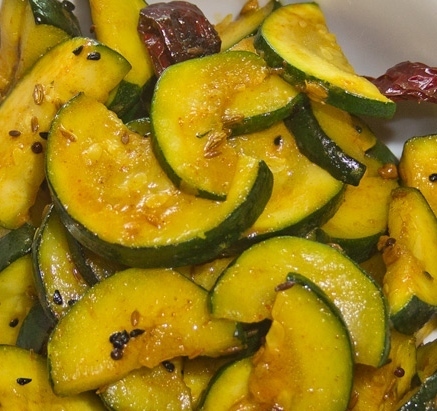
Preparation & cooking: 20 minutes
Ingredients: 2 zucchinis, halved lengthways and sliced thin
vegetable oil for frying
1 and 1/2 tsp of panch phoran, a five-spice mix popular in Bengali cooking, or less to taste
[if there's no Indian store nearby, you can mix your own in this manner:
1/2 tsp cumin seed
1/4 tsp nigella seed
1/4 tsp fennel seed
1/4 tsp black mustard seed
small pinch fenugreek seed (caution: it has a bitter taste)]
2 whole dried chilies
red chili powder to taste--I use 1/4 spoon
1/4 tsp turmeric powder
salt to taste
a pinch of sugar, or more to taste
Heat oil in a frying pan. When the oil is hot, add the panch phoran and whole chilies. When they sputter, add the zucchini pieces and stir for a few minutes. Add the turmeric and red chili powder.Let the zucchini brown a little. Add salt. Lower heat to medium and cover. Stir it every couple of minutes. When the zucchini is cooked but not mushy, remove cover and make sure the liquid gets absorbed and the zucchini gets golden brown. Stir in the sugar. Remove from heat.
Serve with hot rice and lentils.
Let me know if you liked this.

February 18, 2014
The Importance of Attending Writers Conferences
I just got back from the 14th San Francisco Writers Conference, where I was invited as a keynote speaker by the wonderful organizers, Elizabeth Pomada and Michael Larsen. It was such a great experience that I wanted to share some thoughts about it.
I hadn’t been to a writer’s conference in a while. Partly because I was busy. Partly because I felt that now that I had published over a dozen books, I knew the basics of the business and needed only to focus on writing and touring. And partly because crowds make me nervous.
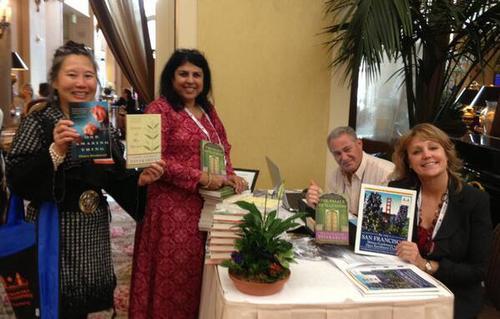
At the San Francisco Writers Conference with presenter Terry LeYung-Ryan and organizers Richard and Barbara Santos
I hyperventilated a bit when I stood up to give my speech in the banquet hall that held over 500 people. But as I started talking about my journey as a writer and sharing writing and marketing tips that had been helpful to me in my career, I was struck by the wave of positive energy in the room. It was so wonderful to be with so many people who loved writing, all of us hoping to get better at what we do and find more effective ways to share our books with readers, and hopefully make a decent living at it. It made me realize how lonely the job of a writer is, and how important it is for us to connect with a community of like-minded people and inspire each other.
The San Francisco Writers Conference is a particularly wonderful one to attend. The location—the historic Mark Hopkins hotel on Nob Hill, with its fabulous views—is gorgeous. There’s a stellar cast of presenters, editors, agents and publicists. They have an excellent track record of past attendees who have gone on to publish successfully. And most of all, the organizers are extremely friendly and helpful and will make you feel right at home. They even arrange networking dinner excursions every night, with affable board member Harvey Pawl as guide, to delicious neighborhood restaurants known only to locals. Here’s a link, if you want to give them a try--but don't delay too much. They are extremely popular and sell out well ahead of time. https://sfwriters.org/

July 20, 2013
Easy Indian Recipes from Oleander Girl
One of the
things I most enjoy writing about in my novels is food. In all cultures--but
particularly in India--food gives us so much more than physical nourishment. It
is woven into customs, history, family lore. Through cooking, people
demonstrate craft, creativity, love and pride.

In Oleander
Girl, my newest novel, set partly in Kolkata and partly in the U.S., food plays
an important role and gives us a glimpse into the hidden depths of the
characters. In the traditional household of the heroine
Korobi, we find authentic Bengali cuisine--fried brinjal and khichuri, but prepared by a long-time cook
given to wild improvisations. In Korobi's fiance Rajat's elegant, westernized
home, Rajat's father makes tiramisu. In New York. Desai, the private
investigator who helps Korobi in her search for a family secret, fixes pau
bhaji in memory of his dead sister.
Today I've invited Sandeepa Datta, a wonderful cook and the author of Bong Mom's
Cookbook, to share a couple of recipes that appear in Oleander Girl. I have a
feeling that you're going to love her easy, healthful versions.
Over to Sandeepa now. Please scroll
down to the bottom for more information about her delicious book.
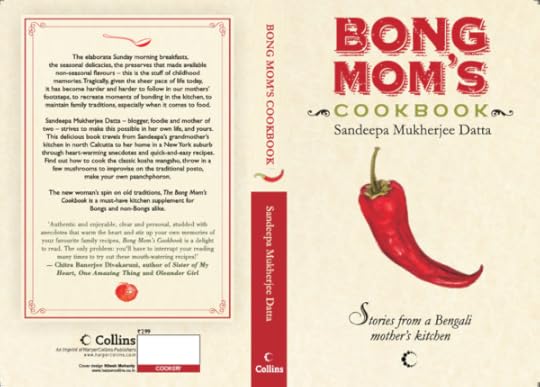
SANDEEPA WRITES:
I am very
proud today to share a few of my recipes with Chitra Banerjee Divakaruni. She
has been an author whose writing I have loved since her first book
"Arranged Marriage". When I migrated to US in 1999, her books echoed
my thoughts and I felt a certain familiarity in her stories. They spoke to me.
Her fictional characters were like my friends in this new country. There have
been times when I have found strength from Anju in “Sister of My Heart”. When Chitra
Banerjee very kindly wrote the cover quote for my book, I was elated.
And today I
am very happy to share recipes of some of the Bengali food mentioned in
“Oleander Girl” with you all.

Begun Bhaja
“Luncheon
smells rice from the kitchen – khichuri made with golden mung and gopal bhog
rice from their ancestral village, sautéed brinjals, cabbage curry cooked with
pure ghee and cardamoms. Sarojini will have to supervise the fish fry.”
–Oleander girl
Begun
Bhaja or Sautéed Eggplant is a very simple Bengali
delicacy. Simply put it is slices of purple eggplant, tossed in turmeric powder
and salt and then shallow fried in hot oil. With a good quality eggplant, the
flesh of the fried being is so soft that it is not wrong to call it
"buttery". Growing up, the begun bhaja was a standard side with dal
and rice and a fish curry in most Bengali homes. It was also served with
fried flatbreads called Luchi or with a rice and lentil mix called Khichuri.
Though Begun
Bhaja is originally shallow fried in the sharp pungent Mustard oil, I try to
make a healthier version where I toss them in olive oil and bake them in the
oven. Here I am sharing a version where I bake them in the oven. You can choose
to shallow fry in oil instead. Easy and delicious.
Wash 1
slender japanese eggplant in water and pat dry. Dry it well.
Chop the
eggplant in rounds, each 1/2" thick.
Toss the slices with
1 tsp
turmeric powder
2 tsp
Olive oil
salt to
taste
To make it more global you can
use some other spices like paprkia or cumin powder too.
Grease a baking tray. Arrange
the eggplant slices on the tray. No piling or overlapping. If you have a cooking
spray, spray the surface of the eggplant slices. Or else you can smear them
with drops of olive oil. Make sure that each slice is coated with a layer of
oil else it will get dry.
Pop in an oven. I used a toaster
oven where I baked them at 300F for about 25-30 mins. After 15
mins from start I turned the tray and sprayed the slices once more. Towards the
end, I flipped the slices, sprayed with little more cooking spray and did it
for 5 more minutes.
Oven temperature and timing will
vary. At my home, the larger oven temp needs a higher temperature, around 350F
for same recipe. Also depending on the quality of the eggplant timing will
vary. Just check that the slices are not getting dry and take them out
once they are soft and cooked. If they are getting dry but not cooked,
cover the bake tray with a aluminum foil and then bake.
Sometimes I might brown them
further on a greased fry pan on the stove after they are done but mostly that
is not necessary for this variety of eggplant.
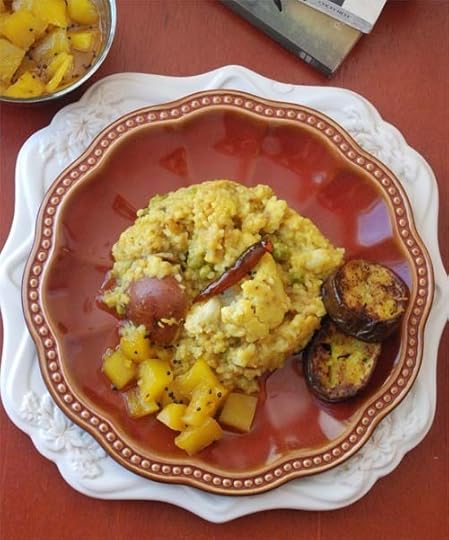
Khichuri
or a Khichdi made with Golden Moong
dal and rice is a Rice and Lentil dish akin to Risotto if I try going
international. The same Khichuri when mixed with devotion, faith, respect and
fragrance of incense, is lifted to the sublime and offered to Gods, it is
called Bhog er Khichuri.
This recipe
of Khichuri is very flexible and you can work around it with ingredients you
have in hand. You can also add more
vegetables to suit your taste and skip some. The whole spices that have been
used to temper the oil are a staple in any Indian kitchen but if you lack a
couple of them, don’t get flustered. Go ahead and try the dish even if you have
only a couple of the spices. Those spices are used to flavor the oil in Indian
cooking and not meant to be eaten whole.
Same for
Ghee. Ghee lends an awesome flavor to this dish but you can substitute with
Butter if your pantry lacks Ghee. I would say don’t hold back but adapt the
recipe to make it your own in your own kitchen.
Just like in
Sarojini’s Kitchen (in Oleander Girl) serve this Khichuri with Begun Bhaja or
sautéed eggplants.
A liitle prep
Chop 2 medium potatoes in halves.
Chop half of a small cauliflower in about 8-10 large-ish florets
Defrost about 1/3 cup of frozen peas (or use same amount of fresh green
peas)
Wash 1/2
cup of rice and soak in water. Short grained gobindobhog rice is best but
basmati will also do.
Roast 1/2 cup of Yellow Moong Dal till you get a nice nutty aroma. About
50% of the dals should be a light brown on roasting. Rinse the dal lightly in
water and keep aside.
In a separate frying pan, fry the potatoes and cauliflower with sprinkle
of turmeric powder till they are a shade of light gold and the cauliflower
florets have some brown spots.bThrow in the green peas and sauté them too.
After we are done with the prep part we will start
on the actual khichuri
Heat 1tbsp vegetable oil + 1 tsp ghee in a deep and heavy bottomed pot.
Temper the oil with
2 green cardamom
2-4 clove/laung
1 thin stick of cinnamom
1 Bay Leaf/tejpata
2 Dry red chilli
1/4 tsp of whole cumin seeds/jeera
When the spices pop add
1 tbsp mince or grated ginger
1/2 tsp cumin powder
1/2 tsp Red chilli powder(or Kashmiri Mirch)
Saute for a
minute. Adjust the chilli powder to you taste.
Next add the roasted moong dal and mix with the masala. Saute the dal
along with the masalas for couple of minutes.
Now add about 2 cups of warm water to the pot. Add little salt.
Cover the pot and let the water simmer to a boil. 2-3 minutes after the boiling
starts add the potatoes, cauliflower and peas. Add some more warm water
if needed. Cover the pot and let the vegetables cook for 2 more minutes. The
moong dal takes longer to cook than the rice so we want the dal to be cooked
half-way before we add the rice.
Add about 1/2 cup of short grained rice now. Mix with the lentils and
veggies and add about 2 more cups
of warm water, salt to taste, ½ tsp turmeric powder. Once you see the water boil, lower
the heat, cover the pot and let the rice and lentils cook. In between, remove
the cover, gently give a stir and check if they are done or if more water is
needed.
Once the rice, lentils and vegetables are cooked, sprinkle about 1/2 tsp of
sugar and a pinch of Garam Masala. Mix gently. Drizzle a tsp more of
ghee if you are feeling generous. Serve hot.
Some of
the other recipes from Oleander Girl can also be found in my blog:
Fish Fry --
Bengali Fish Fry, a Bengali version of their British legacy, breaded
and fried fish-- http://www.bongcookbook.com/2009/11/bengali-fish-fry-anglo-bangla-fry.html
Cabbage Curry
-- BandhaKopir Ghonto -- http://www.bongcookbook.com/2009/03/bandhakopir-ghonto-dry-cabbage-dish.html
Sondesh -- A
popular Bengali dessert made of chhena
or homemade cottage cheese -- http://www.bongcookbook.com/2012/10/sondesh-fabled-bengali-sandesh.html
Recipes for
Cholar Dal and Paayesh are in my book.
ABOUT SANDEEPA AND HER BOOK:
Sandeepa writes: I am a food
blogger, blogging about Indian food, mainly
Bengali food from the eastern part of India at "Bong Mom's
Cookbook". The blog is about the food I cook at home, for my family,
gathering recipes from my Mother, Grandmother, Aunts et al in far off India.
Recently my
book based on the blog was published by Harper Collins.
The book has
been much acclaimed by Indian media and here is what a leading Indian daily
"The Indian Express", says about it, "a rich tapestry of
recipes weaved in between stories of Datta's childhood in West Bengal
and Bihar and post-marriage life in New Jersey. ....a hilarious read where
Didas' and Mashis' grumble about the inequity of neighbours and the planning of
weddings all the while trying to raise offspring on a diet of Maach and
Rabindrasangeet."
The book is
not written as a traditional cookbook and is an enticing mix of food related
anecdotes and traditional Bengali recipes. This is what I write in the "Introduction"
on the book and which I feel rightly surmises the book.
"As I see it, recipes are a mere framework, guidelines to help you
create your own food memories; to experiment and make it your own; to find your
own joy and spice box in the kitchen and to weave your own tale. That is what I
want you to do with the recipes in this book. I did not write this book as a
cookbook and the recipes shared here are those I cook at home according to the
tastes of my family of four. When it comes to you, adjust, taste, create and,
most importantly, enjoy the process, for the food is good but the story that
you knit around it is better. This is my story, but it might well be yours and
maybe even yours. "
The book is available from Amazon and Flipkart. More about
the book here: http://www.bongcookbook.com/p/the-book.html

July 6, 2013
How America Made Me into a Writer
This Independence Day I found myself thinking about my relationship with
America, and what I appreciate about living in this country. It struck me that
one of the most important changes in my life that came about as a result of my
immigration to America is that I became a writer. In India, growing up in a
traditional family, I had never considered being a writer. I did not think I
had the talent; more importantly, I did not think I had a story to tell. Moving
to a very different culture and learning to live on my own made me see the
world much more clearly.
In those pre-internet days--we did not
even have a T.V. in our home in Kolkata--I knew very little about life in the
United States. As a result, when I arrived in America, almost everything was
new to me. From shopping in grocery stores as large as warehouses, to seeing a
film on a gigantic drive-in movie theater, to the dangerously heady freedom of
purchasing items using my very first student charge card, it was all exciting
and sometimes bewildering. I appreciated the freedom and anonymity of being in
a city where only a handful of people knew who I was. I worked hard at menial,
minimum-wage jobs to put myself through college and learned for the first time
what dignity of labor meant. I missed my family and their sheltering arms
so much that it was like having a hole in my heart. I thought about India more
than I had ever before. I realized what I appreciated about it--the warmth, the
closeness of extended family, the way spirituality pervades the culture. But I
also recognized problems about how women are often treated, and a rigid class
system because of which many doors are closed to all but the most fortunate and
most well-connected people.

EARLY DAYS IN CALIFORNIA
All around me I saw other immigrants (not necessarily only Indians) who were
undergoing similar experiences of culture-shock, who were carving out new
identities for themselves and trying to preserve the most valuable aspects of
their home cultures. I saw them trying to bring up children in a new
environment where the old parenting rules didn't quite work. I saw how, even as
they underwent a transformation, they too were transforming America. I read
their stories in the local papers, I overheard their conversations at Indian
parties, I imagined the things they didn't say and wove them together with my
own feelings and questions, and I fictionalized it all in stories that
ultimately became my very first collection, Arranged Marriage, and later,
novels such as The Mistress of Spices, Queen of Dreams, and Oleander Girl.
Sometimes I'm asked if I would have
become a writer if I hadn't moved to the United States. I don't know the answer
to that question. I do know, though, that I couldn't have written the same
kinds of stories, hybrids born out of the melding of the Indian and American
cultures.


June 26, 2013
Mothers in My Fiction
(This post was originally written in May, just before Mother's Day. Because it was moved to a new site, it is postdated to June).
Mother's Day reminds me of how important my
mother, who pretty much brought us up as a single parent, has been in my
life. Perhaps
the many mothers that I depict in my books--though they have little
similarity
to the biographical facts of her life-- are my attempt to understand the
loving, stern, mysterious woman she was. (She passed away a few years
ago. Here is one of the last photos I have of her, at my niece Neela's
wedding.)

Some instances of mothers in my books: In the
final story in my collection Arranged Marriage, there is the mother who must,
in the wake of her failed marriage, establish a new kind of bond with her
teenage son. In Sister of My Heart, there are three strong mother figures that
bring up the protagonists Sudha and Anju, each focusing on a different aspect
she considers crucial: physical beauty, studies, and mythological stories. And
in my newest novel, Oleander Girl, Korobi's mother Anu, who died at childbirth,
naming her daughter after a beautiful but poisonous flower, is an enigma who
haunts Korobi until she must put off her marriage and travel from Kolkata to
New York to discover the secret that lies at the heart of Anu's life.
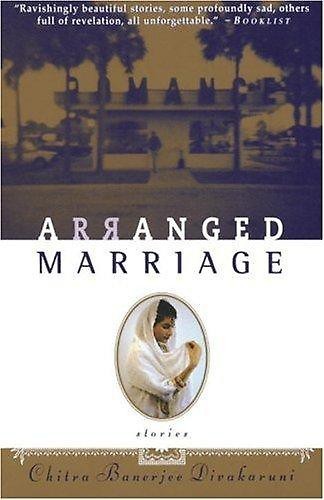
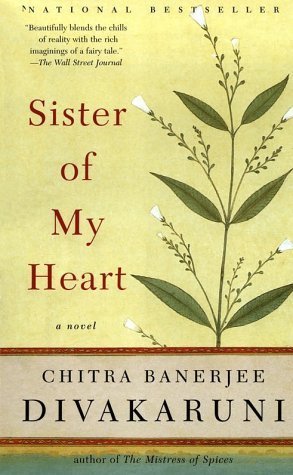

I don't think I'm done writing about mothers--my next novel will feature
Sita (heroine of the epic The Ramayana), one of literature's first
single mothers.
7 Likes
the writing life (1)

June 1, 2013
Giving a Successful Author Talk: Three Ideas
Three things I consider important are:
1. Tell the audience something they wouldn't know just from reading the back jacket of the book, or from reviews and interviews. Something personal. With Oleander Girl, I often talk about how my grandfather was an inspiration for Korobi's grandfather, the loving but stern Bimal Roy who kept a huge secret from her all his life.
[image error] At Evergreen Valley College, San Jose
2. Keep the presentation short, enjoyable and appropriate without dumbing it down. Leave them wanting more. I try to be aware of who the audience is, and what the people sitting in front of me would be interested in. Is it a general bookstore or author luncheon audience? Are they writers or writing students? Are they people from my Indian background? I gear my talk toward what would be of interest to them.
[image error] At the New York Public Library
3. Be willing to do a question and answer session. People love to engage one on one with speakers, and a question and answer session is perfect for that. It's also good to offer to sign books afterwards, for those people who are too shy to speak up in a crowd. Questions from the audience also make me think of my writing in different ways, and to be aware of what readers are getting out of my books. A question I'm asked often is where I get ideas for my books. I give various answers: Oleander Girl and Sister of My Heart came out of visits to India and what I saw during these trips; Palace of Illusions came out of childhood evenings when my grandfather told me the story of the Mahabharat; Arranged Marriage came out of the gossip I overheard at Indian parties. But ultimately, it's a mystery to me where story ideas come from.
[image error] At a middle school in the Houston area

Giving a Successful Author Talk: Three Ideas
Being on tour for Oleander Girl and Grandma and the Great Gourd has made me think a great deal about what makes a successful author event.
Three things I consider important are:
1. Tell the audience something they wouldn't know just from reading the back jacket of the book, or from reviews and interviews. Something personal. With Oleander Girl, I often talk about how my grandfather was an inspiration for Korobi's grandfather, the loving but stern Bimal Roy who kept a huge secret from her all his life.
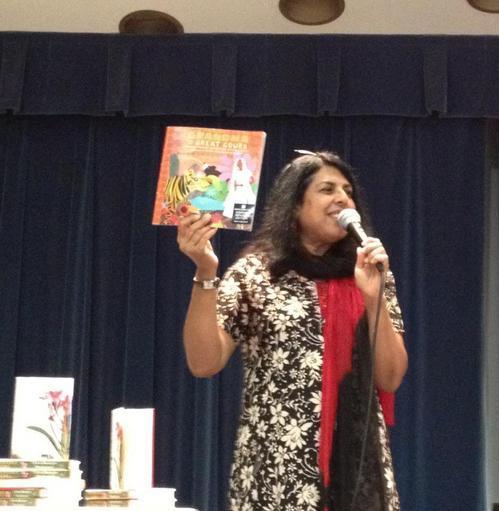
At Evergreen Valley College, San Jose
2. Keep the presentation short, enjoyable and appropriate without dumbing it down. Leave them wanting more. I try to be aware of who the audience is, and what the people sitting in front of me would be interested in. Is it a general bookstore or author luncheon audience? Are they writers or writing students? Are they people from my Indian background? I gear my talk toward what would be of interest to them.

At the New York Public Library
3. Be willing to do a question and answer session. People love to engage one on one with speakers, and a question and answer session is perfect for that. It's also good to offer to sign books afterwards, for those people who are too shy to speak up in a crowd. Questions from the audience also make me think of my writing in different ways, and to be aware of what readers are getting out of my books. A question I'm asked often is where I get ideas for my books. I give various answers: Oleander Girl and Sister of My Heart came out of visits to India and what I saw during these trips; Palace of Illusions came out of childhood evenings when my grandfather told me the story of the Mahabharat; Arranged Marriage came out of the gossip I overheard at Indian parties. But ultimately, it's a mystery to me where story ideas come from. 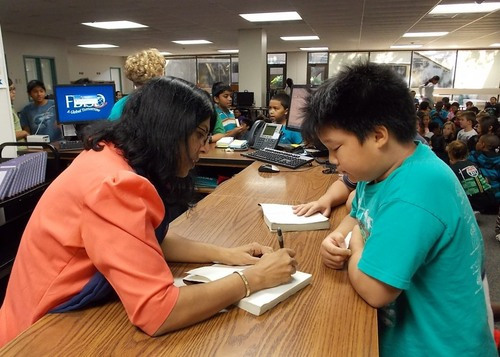
At a middle school in the Houston area

May 30, 2013
Goodreads Author Chat Today, 5/30, on Oleander Girl
today, Thursday 5/30, on the Authors/Readers site. They have posted an
interview Goodreads has done with me about my new novel, Oleander Girl. You can type
in questions all day, and I will answer them throughout the day.
Please go to this link to sign up for the group and the chat. You can
then also participate in any of their future chats with authors. http://www.goodreads.com/group/show/26989-goodreads-authors-readers




